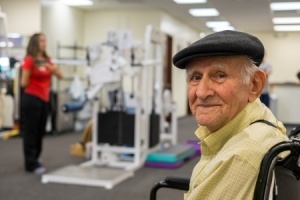This is part 2 of a series of 9 partnerships every assisted living community should have that was first presented at the Marcus Evans Long Term Care Summit In Florida. See the side bar for the complete list of partnerships in the series.
We have our own therapy company and we were looking to grow it. We had started keeping track of the percentage of residents in each community who were receiving therapy. One day we were looking at the therapy utilization reports and noticed that the community with the lowest average length of stay had the lowest therapy utilization rates.
| 9 Partnerships |
|---|
| Introduction |
| 1 – Therapy / Home Health |
| 2 – Physician Group |
| 3 – Skilled Nursing Facilities |
| 4 – Pharmacy |
| 5 – Home Care Companies |
| 6 – A Real Estate Company |
| 7 – DME & Ambulance Companies |
| 8 – Hospice |
| 9 – A Coach |
The light dawned . . . it was clear there was a direct correlation between therapy, the length of stay and, more importantly, longevity of our residents.
When we reviewed our utilization in all our communities we discovered that the communities with the higher length stay had 25% of their residents on therapy at any given time. The community that had 12 months average length of stay had less than 10% of their residents on therapy at any given time.
Low Therapy Utilization
We found out that there were 3 reasons why they had that low utilization of therapy.
- We had the same therapy directors for our assisted living communities and our skilled facilities. We found that when therapy directors were responsible for scheduling therapist in both assisted living and skilled nursing, the directors were moving therapists to the skilled facility when Medicare Part A census went up. The result was lower therapy utilization in assisted living and that practice negatively impacted our assisted living residents.
- We found outside therapy and home health therapy providers were not assessing the residents frequently enough. We saw that in the assisted communities with optimal utilization of therapy, all the residents were assessed quarterly and every time was a change in the resident’s condition . . . not just when a resident had been to the hospital or had a fall, but every time they’d been sick.
- Therapists who had previously worked in hospitals believed that people regain the majority of their functionality during the first six months of therapy and that therapy after that doesn’t really matter. So they often ended the resident’s term of treatment prematurely.
Once we changed our practices, the assisted living leadership team became the biggest advocates for additional evaluations and making sure residents received all of the therapy they knew they could benefit from.
Getting the Therapy Thing Right
You can leverage your therapy services to improve occupancy and resident longevity with these steps:
- Track your average length of stay and your utilization of therapy every month.
- You need to partner with therapy companies and home health companies that will:
- Commit to having 25% of your AL residents on therapy at all times.
- Do quarterly evaluations as well as evaluating residents after every change in condition.
- Work with your therapy vendor to make sure residents have the same therapists for home health and outpatient therapy.
Finally, as in all of your partnerships, you must hold them accountable by tracking the numbers that indicate they are adhering to your requirements and getting the optimal outcomes for your residents.
Since you will limit how many therapy companies you’re partnering with you will be giving them a great deal of business so they should be receptive to your recommendations and be more than willing to provide your residents with the greatest opportunity to enjoy a longer life.
Scott Middleton
If you like this article (or even if you don’t) it would be a great honor to have you subscribe to our mailing list HERE








